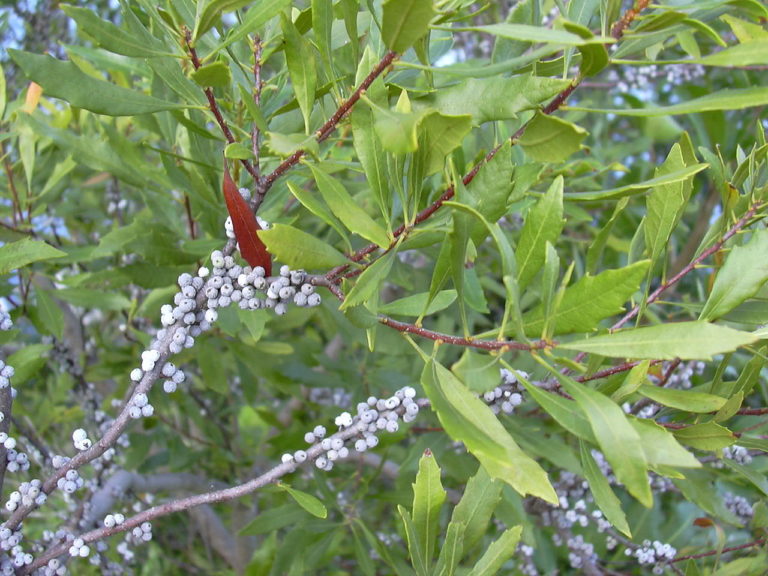Wax Myrtle is an amazingly versatile evergreen shrub or small tree which is such a great wildlife plant that it could be useful for increasing the pollinators and birds in your yard. Its foliage is very fragrant, and evergreen, and the blue berries are attractive to people as well as to a whole range of birds. When birds digest the seeds, the wax is removed, so that the seeds that are thereby spread are able to germinate. This plant is also the larval host plant for Banded Hairstreak and Red Banded Hairstreak butterflies and the Polyphemus Moth, and other insects that keep a garden healthy. It is popular with landscapers because of its amazing tolerance of soil moisture variations from very dry to very wet (check out its Natural Distribution) its evergreen habit, and ease of cultivation. Wax Myrtle prunes well and is easy to maintain. This shrub is also tolerant of high winds and salt spray, and may be grown in seaside areas. It fixes atmospheric nitrogen which helps it survive in poorI soils. It is probably most often used mixed with other shrubs for hedges and privacy screens, taking advantage of a tendency to sucker. Wax Myrtle in nature occurs from the Florida Keys north to southern New Jersey, Maryland, and Delaware; west to eastern Texas, southeast Oklahoma, and central Arkansas. It is first cousin to the Bayberry (Myrica pennsylvanica) whose range is more northerly, and with whom it hybridizes. Bayberry serves better in zones colder than zone 6. Wax Myrtle, by contrast, is the southern heat-loving evergreen species. Candles have historically been made from the wax on the berries of both species. Wax Myrtle was the Georgia Native Plant Society’s Plant of the Year in 2002.
NURSERY HOURS
Wednesday: 10-4 Thursday: 10-6 Friday-Saturday: 10-4 Sunday: 12-4
Morella cerifera

Key Info
Scientific Name: Morella cerifera (L.) Small
Common Names: Wax Myrtle, Southern Wax Myrtle, Southern Bayberry, Eastern Bayberry, Candleberry, Tallow Shrub, Bayberry,
Family Names: Myricaceae (Myrtle Family)
Plant Type: Tree / Shrub
Leaf Retention: Evergreen
Flower Color: Inconspicuous
Additional Info
Habit: Wax Myrtle is an irregular, multi-trunked, colonial shrub with many arching, twisting and upright branches: growing in drier and sandier areas it tends to be more shrub-like, with smaller leaves, whereas those growing in damper situations, with richer soil, are more tree-like with bigger leaves. Texture is fine to medium, bark thin and smooth, gray-brown.Wax Myrtle can be limbed up for a tree-like appearance if desired.
Height: up to 35' (normally 12')
Spread: 8' to 10' (or more)
Soil Conditions: Average, dry or wet soils; acidic (pH<6.8), circumneutral (pH 6.8-7.2); light (sandy), medium (loamy) and heavy (clay); prefers well-drained soil.
Leaves: Alternate, simple, fragrant, oblanceeolate in shape with a tapered base, toothed margins above the middle, leathery texture and pinnate venation; glossy olive-green and waxy-shiny above, pale green below, yellow resin dots on both surfaces.
Flowers (or reproductive structures: Wax Myrtle is dioecious; both male and female flowers are small (1/2 inch), appearing as catkins in the leaf axils in spring. The flowers are fragrant but non-showy. Female flowers are green. Male catkins 1" long are a drab yellowish green. Male flowers have three or four stamens, and are surrounded by short bracts. The flowers bloom in late winter to early spring.
Fruit: Pollinated female flower clusters develop into small, attractive clusters of tiny, globose, blue/silver fruits which mature in late summer to fall, persisting through winter. Each fruit is coated by an aromatic waxy substance. Birds eat the fruits in fall and winter, thus helping the plants to naturalize by disbursing the seed.
Natural Distribution: Wax Myrtle is above all, adaptable to the moisture levels of many habitats: "Wax myrtle's ecological amplitude is demonstrated by reported growth on fresh to slightly brackish banks and shores, flats and interdune swales, pine and palmetto flatwoods and savannas, cypress-gum ponds and swamps, wet and dry prairies, pitcher-plant bogs, upland mixed woodlands, old fields, and fence and hedge rows" (FEIS). But as for temperature, it appears to be restricted to climates with mild winters and long, hot, humid summers at elevations below 500 feet.
USDA Hardiness Zone: 6 to 11
USDA Wetland Indicator Status in NC: FAC
Pollination: Wind
Wildlife Connections: The berries are relished by many songbird species, including the bluebird, tree swallow, catbird, myrtle warbler, and the Georgia State Bird, the brown thrasher; also yellow-rumped warbler, the Carolina wren and species of tree sparrow, the northern bobwhite quail and the wild turkey. The foliage is larval host for Banded Hairstreak and Red Banded Hairstreak.
Propagation: By seeds, or by softwood cuttings.
